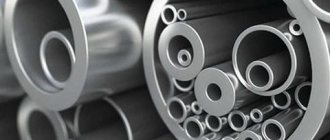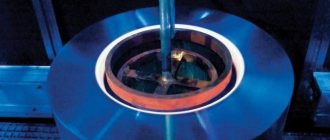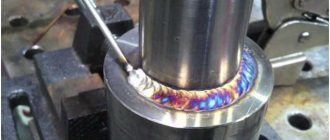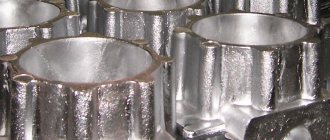General methods for obtaining metals
The significant chemical activity of metals (interaction with atmospheric oxygen, other non-metals, water, salt solutions, acids) leads to the fact that in the earth’s crust they are found mainly in the form of compounds: oxides, sulfides, sulfates, chlorides, carbonates, etc. In free form, there are metals located in the voltage series to the right of hydrogen (Ag, Hg, Pt, Au, Cu), although much more often copper and mercury can be found in nature in the form of compounds.
Minerals and ferrous rocks containing metals and their compounds, from which the isolation of pure metals is technically possible and economically feasible, are called ores
.
Obtaining metals from ores is the task of metallurgy.
Metallurgy
is both the science of industrial methods for obtaining metals from ores and a branch of industry.
Any metallurgical process is a process of reduction of metal ions using various reducing agents. Its essence can be expressed as follows:
M n+ + ne−→M
To implement this process, it is necessary to take into account the activity of the metal, select a reducing agent, consider technological feasibility, economic and environmental factors.
In accordance with this, there are the following methods for obtaining metals:
• pyrometallurgical;
• hydrometallurgical;
• electrometallurgical.
Pyrometallurgy
Pyrometallurgy is the reduction of metals from ores at high temperatures using carbon, carbon monoxide (II), hydrogen, metals - aluminum, magnesium.
For example, tin is recovered from cassiterite SnO2, and copper from cuprite Cu2O
calcination with coal (coke):
SnO2+ 2С = Sn + 2СО ↑; Cu2O + C = 2Cu+ CO ↑
Sulfide ores are pre-roasted in the presence of air, and then the resulting oxide is reduced with coal:
2ZnS + 302 = 2ZnО + 2SO2 ↑; ZnO + C = Zn + CO ↑ sphalerite (zinc blende)
Metals are also isolated from carbonate ores by calcination with coal, since carbonates decompose when heated, turning into oxides, and the latter are reduced by coal:
FeСO3 = FeО + СO2 ↑ ; FeO + C = Fe + CO ↑ siderite (spar iron ore)
By reduction with coal one can obtain Fe, Cu, Zn, Cd, Ge, Sn, Pb and other metals that do not form strong carbides (compounds with carbon).
Hydrogen or active metals can be used as a reducing agent:
1) MoO3 + 3H2 = Mo + 3H2O (hydrothermy)
The advantages of this method include obtaining very pure metal.
2) TiO2+ 2Mg = Ti + 2MgO (magnesium thermia)
3МnO2 + 4Аl = 3Мn + 2Аl2O3 (aluminothermy)
Aluminum is most often used in metallothermy, the heat of oxide formation
which is very high (2A1 + 1.5 O2 = Al2O3 + 1676 kJ/mol). The electrochemical voltage series of metals cannot be used to determine the possibility of reactions occurring in the reduction of metals from their oxides. The possibility of this process can be approximately determined by calculating the thermal effect of the reaction (Q), knowing the values of the heats of formation of oxides:
Q= Σ Q1 - Σ Q 2,
Features of copper ores
Copper-containing ores are characterized as multi-element. The most common connections are with:
- iron;
- gray;
- copper.
The following may be present in minor concentrations:
- nickel;
- gold;
- platinum;
- silver.
Deposits all over the world have approximately the same set of chemical elements in the ore composition; they differ only in their percentages. To obtain pure metal, various industrial methods are used. Almost 90% of metallurgical enterprises use the same method for producing pure copper - pyrometallurgical.
One of the largest ore mines produces 17 million tons of copper per year
The design of this process also makes it possible to obtain metal from recycled materials, which is a significant advantage for industry. Since the deposits belong to the group of non-renewable deposits, reserves decrease every year, ores become poorer, and their extraction and production becomes expensive. This ultimately affects the price of the metal on the international market. In addition to the pyrometallurgical method, there are other methods:
- hydrometallurgical;
- fire refining method.
Industrial methods for obtaining metals
There are several ways to obtain metals in industry. Their use depends on the chemical activity of the element obtained and the raw materials used. Some metals occur in nature in pure form, while others require complex technological procedures to isolate them. The extraction of some elements takes several hours, while others require many years of processing under special conditions. Common methods for obtaining metals can be divided into the following categories: reduction, roasting, electrolysis, decomposition.
There are also special methods for obtaining rare elements, which involve creating special conditions in the processing environment.
This may include ionic decrystallization of the structural lattice or, conversely, a controlled polycrystallization process that allows the production of a specific isotope, radioactive irradiation and other non-standard exposure procedures.
They are used quite rarely due to the high cost and lack of practical application of the selected elements. Therefore, let us dwell in more detail on the main industrial methods of producing metals. They are quite varied, but all are based on the use of chemical or physical properties of certain substances.
Main methods of obtaining metals
One of the main ways to obtain metals is their reduction from oxides. It is one of the most common metal compounds found in nature. The reduction process takes place in blast furnaces under high temperatures and with the participation of metallic or non-metallic reducing agents. From metals, elements with high chemical activity are used, for example, calcium, magnesium, aluminum.
What is hydrometallurgy?
Hydrometallurgy is a branch of industrial chemistry in which we use an aqueous solution to extract metal from ores, concentrates, processed or residual material, etc. There are three main areas of hydrometallurgy: leaching, concentration and purification, and metal recovery.
The leaching process can be carried out in different ways, such as: in-situ leaching, heap leaching, vat leaching, tank leaching and autoclave leaching. These are the five main types of leaching. The leaching process uses an aqueous solution to extract metal from ore. The solution that is used specifically in hydrometallurgy is called leach solution. It can have different pH values, redox potential, chelating agent composition, temperature and other properties depending on the type of metal we are going to extract. These reaction conditions vary depending on the need to optimize reaction rate, extent and selectivity of dissolution, etc.
The next stage of hydrometallurgy is the concentration and purification of the solution. This step involves concentrating the metal ion in the leach liquid and removing unwanted metal ions. The main steps involved in this stage are precipitation, cementation, solvent extraction, ion exchange and electrochemical extraction.
The metal extraction stage is the final stage of hydrometallurgy. The metal obtained at this stage is suitable for direct sale. However, when we need ultra-high purity metal, additional purification is necessary. Metal extraction can be carried out in two ways: electrolysis and precipitation.
Properties of ores
Answering the question: what properties does iron ore have is not entirely simple. If only because the list of properties depends on the percentage of a given metal in the ore and the amount of foreign impurities. For example, red iron ore containing hematite (Fe2O3) contains as much as 70% of the total iron.
In general, by the way, only those where the ores contain 40% iron or more are considered viable iron mining. This figure really makes it clear that iron is widespread in the surrounding world many times more than other elements. For example, for the same uranium, its content in the ore in the amount of 2% would be considered an unprecedented success...
But let's return to our red iron ore. When characterizing iron ore, we can say that red iron ore ranges from a powdery substance to a dense one.
Limonite (also known as brown iron ore) is also an iron ore, but it is a porous and friable rock containing significant proportions of phosphorus and manganese. Clay is often used as waste rock. Due to this, by the way, it is quite easy to extract iron. That’s why cast iron is often made from it.
Copper production in Russia and the world
According to analytical agencies, the Russian Federation confidently occupies fifth position among countries engaged in the mining and production of pure copper. Copper production in Russia on average per year is 860 thousand tons. The basis of the modern structure of copper production is made up of three large holdings: OJSC MMC Norilsk Nickel (Norilsk Nickel), LLC UGMKHolding (UMMC) and CJSC Russian Copper Company (RMK). These companies carry out a full production cycle from ore mining to the production of finished ingots, rolled products and wire. Each holding includes several enterprises equipped with the most advanced production technologies. Thanks to dynamic development, last year it was possible to increase copper production by seven percent.
Global copper production is fairly consolidated. Almost 35% of this metal is produced by the five largest companies. These include:
- Codelco (Chile).
- Freeport-McMoRan (USA).
- Glencore (Switzerland).
- BHP Billiton (Australia).
- Southern Copper (Mexico).
These companies obtain almost 80% of copper from primary raw materials (that is, they carry out a full processing cycle) and produce 20% as a result of processing incoming scrap. In Europe, the largest copper producers are: Poland, Portugal and Bulgaria. Each plant is capable of producing a wide range of copper products. Despite the current crisis, copper still remains a sought-after metal. One of the serious disadvantages inherent in this production is environmental problems. Assessments of emissions from copper smelters showed high levels of ambient air pollution. It contains a large number of chemical compounds harmful to health (cadmium, mercury, arsenic, lead, nitrogen oxides and carbon).
Hydrometallurgical copper production technology
Copper ore may also contain gold
This method is not widely used because it can result in the loss of precious metals contained in the copper ore.
Its use is justified when the rock is poor - it contains less than 0.3% of red metal.
How to obtain copper using the hydrometallurgical method?
First, the rock is crushed to a fine fraction. Then it is placed in an alkaline composition. The most commonly used solutions are sulfuric acid or ammonia. During the reaction, copper is replaced by iron.
Cementation of copper with iron
The solutions of copper salts remaining after leaching undergo further processing - cementation:
- iron wire, sheets or other scraps are placed in the solution;
- during a chemical reaction, iron displaces copper;
- As a result, the metal is released in the form of a fine powder, in which the copper content reaches 70%. Further purification occurs by electrolysis using a cathode plate.
Corrosion
Corrosion is a process of spontaneous destruction of alloys and metals that occurs under the influence of the environment. Rust begins to appear when exposed to oxygen, water, sulfur oxides, and carbon.
Types of corrosion:
- atmospheric.
- electrolytic;
- gas;
- lifting;
- biological.
It is impossible to imagine human life without metals. They are used in various fields of activity. The process of mining metal ore to make homogeneous materials or alloys has remained virtually unchanged for hundreds of years. New equipment and technology appeared, but the essence of the process remained the same.
Types of alloys
Despite such a variety of alloys, those based on iron and aluminum are of greatest importance to people. They are the ones that are most often encountered in everyday life. There are different types of alloys. Moreover, they are divided according to several criteria. Thus, various methods of producing alloys are used. According to this criterion they are divided into:
• Cast, which are obtained by melt crystallization of mixed components.
• Powder, created by pressing a mixture of powders and subsequent sintering at high temperature. Moreover, often the components of such alloys are not only simple chemical elements, but also their various compounds, such as titanium or tungsten carbides in hard alloys. Their addition in certain quantities changes the properties of metallic materials.
Methods for producing alloys in the form of a finished product or billet are divided into:
• foundries (silumin, cast iron);
• deformable (steel);
• powder (titanium, tungsten).
Equipment
Various equipment is used for production and processing:
- For heat treatment - furnaces, smelters, forges.
- To change the roughness of surfaces - grinding machines, sandblasting.
- To create recesses, process edges, ends - slotting, drilling, milling machines.
- To give a simple or complex cylindrical shape - lathes.
- For cutting workpieces - saws, laser or waterjet cutters.
Modern equipment is equipped with automatic control systems, which speeds up production and minimizes physical costs on the part of humans.
Homemade horn (Photo: Instagram / vetal7070)
Description
These are chemical processes occurring in metallurgical units at high (800-2000°C) temperatures. Therefore, pyrometallurgy is sometimes called “high temperature chemistry.” Often chemical reactions are accompanied by a change in the aggregate state of the reacting substances: melting, sublimation, evaporation of the resulting metals or their compounds. In such processes, interactions can occur between solid, liquid (melts) and gaseous phases in any combination.
Pyrometallurgical processes are the processes of agglomeration of metallurgical raw materials, smelting of charge materials, production of alloys, and refining of metals. In particular, this is roasting, blast furnace smelting, open-hearth smelting, smelting in converters, arc and induction furnaces. Pyrometallurgy is the basis for the production of cast iron, steel, lead, copper, zinc, etc.
In pyrometallurgy, carbon reduction is often used - in cases where the metals being reduced do not form stable carbides, in addition to those mentioned above, such metals include germanium, cadmium, tin and others. In cases where stable carbides are formed by reduced metals, metallothermy is often used instead of reduction with carbon.
Pyrometallurgy is the main and most ancient field of metallurgy. From ancient times until the end of the 19th century, metal production was based almost exclusively on pyrometallurgical processes. At the turn of the 19th and 20th centuries, another major branch of metallurgy, hydrometallurgy, acquired industrial importance. However, pyrometallurgy continues to maintain a dominant position both in terms of production scale and variety of processes.
At the beginning of the 20th century, along with flame heating methods, different types of electric heating (arc, induction, etc.) began to be used in metallurgy; Around the same time, electrolysis of molten chemical compounds was introduced into industry (production of aluminum and other non-ferrous metals).
In the 2nd half of the 20th century, plasma melting of metals, zone melting and electric fire melting became widespread. Metallurgical processes based on the use of electric current are classified as an independent field of pyrometallurgy - electrometallurgy.









